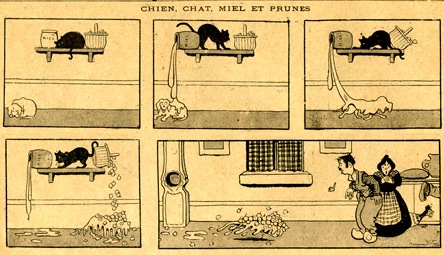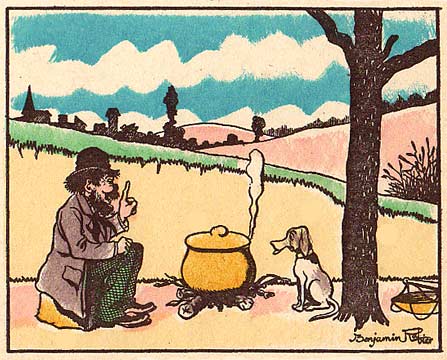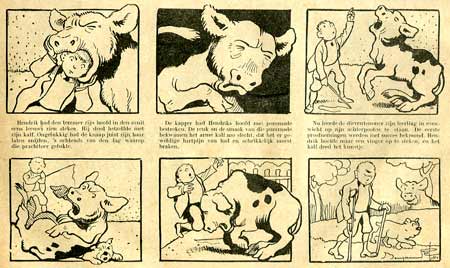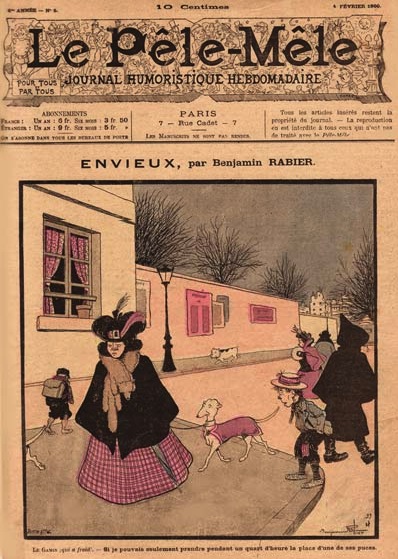'Gédéon'.
Benjamin Rabier is one of the masters of early French comics and an animation pioneer, best known for his animal drawings. Born in La Roche Sur Yon as the son of a carpenter, he moved to Paris with his family at age 5. Although he won the first prize in a Parisian drawing competition twice (in 1879 and 1880), he started out working as a bookkeeper. One of Rabier's graphic influences was Auguste Vimar.
'Chien, Chat, Miel et Prunes' (Le Pêle-Mêle, 1900).
With the help of Caran d'Ache, Rabier's first drawings were published in magazines like La Chronique Amusante and Le Gil Blas Illustré. Until 1895, he earns most fame in England and the USA, where he draws for Scraps, Pictorial Comic Life and Puck magazine.
Comic art by Benjamin Rabier.
Rabier got married in 1894 and settled in the Ségur region. It was at this time that he knew his first success in France. He became a regular contributor to the newspaper Le Rire, but he experienced his real breakthrough as one of the initial artists of Le Pêle Mêle in September 1895. He also drew for the magazines L'Assiette au Beurre and Le Chat Noir, as well the publications of Arthème Fayard (La Jeunesse Illustrée and Les Belles Images).
'Le Déjeuner du Chemineau' (Imagerie d'Epinal #2595).
Rabier additionally contributed to the Images d'Epinal prints of Imagerie Pellerin. In 1898, he produced the book 'Tintin Lutin', about a little boy with a quiff, and his little dog. In 1908, 'Tintin-Lutin' was also translated in Dutch as 'Piet Wipneus'. The quiffed Tintin-Lutin and his dog were an inspiration for Hergé, who based Tintin and Snowy on them.
Comic art by Benjamin Rabier.
At the turn of the 19th into the 20th century, Rabier was an established artist, whose work appeared in a great many publications. He began to produce more albums and illustrated the tales of Jean de la Fontaine. He also wrote theater plays and did book illustrations. Rabier had to quit his daytime job as a market inspector for medical reasons in 1910. From then on, he spent all his time on his artistic occupations.
'Tintin Lupin' (1898), perhaps the inspiration for Hergé's Tintin?
Rabier began working in animation in 1916. He approached animation pioneer Émile Cohl to make an animated series based on his comic characters. The series, 'Les Dessins Animés de Benjamin Rabier' ran throughout most of the 1910s and met with great local success, as distributed by the Agence Générale Cinematographique (AGC). The franchise was eventually put to a halt when Cohl objected to the fact that he wasn't credited for his work in advertisements. Rabier then continued the series on his own.
Rabier also worked in the advertising field. For example, he developed the famous cow logo of the cheese brand La Vache Qui Rit ("The Laughing Cow"). In 1923 he created 'Gédéon', a goose whose adventures he drew until the end of his life. Sixteen books appeared between 1923 and 1939. In 1936, he went to work for British publishers again, illustrating several small books.
Benjamin Rabier was an influence on René Hausman, Hergé, Edgar P. Jacobs, Jean-Louis Lejeune, Raymond Macherot, Albert Uderzo, Tomi Ungerer, Arthur White , Frank M. Williamson.
'Envieux', printed on the front cover of Le Pêle-Mêle, 4 February 1900.








